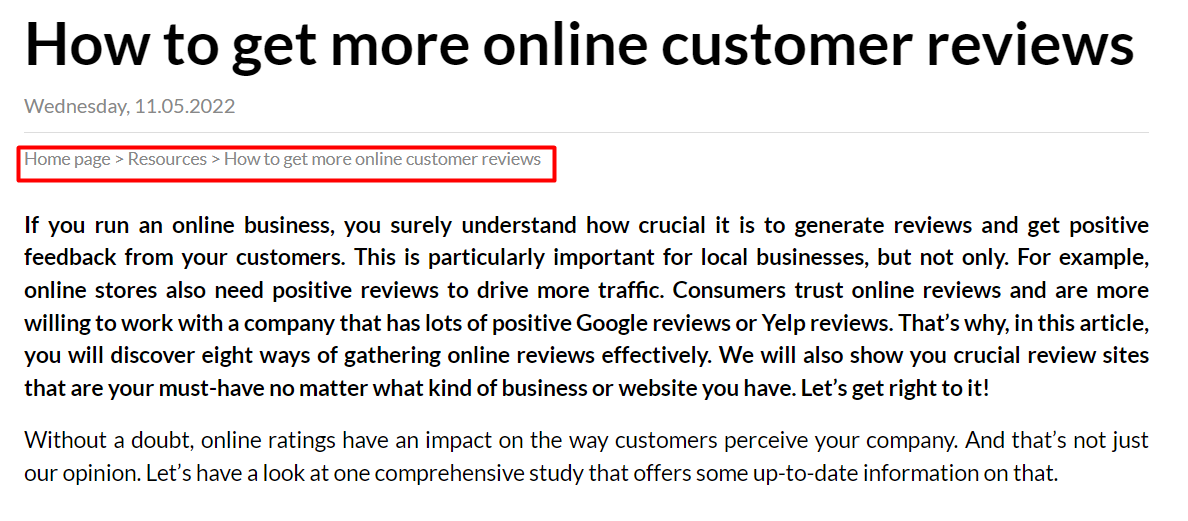What are breadcrumbs in SEO?
Have you ever heard of breadcrumbs on a website? It’s a solution that’s often put aside, despite being necessary for Internet users and search engine robots. This navigation tool can tell your visitors where they are on your site, but it can also help Google understand your site’s structure.
In this blog post, we’re going to take a closer look at breadcrumbs. We will also look at the importance of this type of navigation for a page’s position in search results. Are you interested? We invite you to read the whole post!
Breadcrumb is a valuable tool for both web designers and SEO managers. First, it allows the search engines to understand your website’s construction and hierarchy. Then, it informs visitors of their position at a particular time on the site.
However, it is worth bearing in mind that not all websites must implement breadcrumbs. That may be an unnecessary investment of time for sites with straightforward structures. So some website owners are deliberately opting out of breadcrumb navigation.
However, that does not change the fact that the vast majority of people who reject this concept are not aware of its existence or do not necessarily consider it useful because they do not see the real impact of this type of navigation on SEO. However, the potential of breadcrumbs for natural referencing and organic site search is substantial.

Before examining the impact of website breadcrumbs on your site’s SEO, let’s look at its definition. Breadcrumb is a navigation element integrated with the website’s source code that indicates the path to each page.
In most cases, the breadcrumbs are placed at the top, just before the main title, and consist of consecutive links structured according to the site architecture.
It does not replace the main menu but is added to it to help with navigation. As a result, it is an efficient tool on platforms with many levels and subpages.
The path for breadcrumbs usually looks like that:a
Home page> First Page > Second Page >…> Current page
The “>” symbol is used to separate each level and to indicate the page hierarchy. Some sites also use straight quotation marks (»), slashes (/), or arrows (→).

IMPORTANT TIP: DO NOT LINK TO THE CURRENT WEB PAGE
The last position in the breadcrumb schema, the user’s current page, is optional. However, if you want to view it, make sure it isn’t clickable. Since users are already on this page, adding a link from the same page to the breadcrumb doesn’t make any sense.
As you may have already noticed, behind breadcrumb navigation there is a concept of informing the user at all moments where they are in the site hierarchy and its structure.
Many paths lead from the site’s home page via a hyperlink to the specific subpage. As with a tree, the user goes from the root to individual branches.
Indexing robots can easily recognize this nested structure in the HTML source code. The navigation path also helps users find their way through the different levels and switch between them.
Given the definition of breadcrumbs and the role they play on your website, you can immediately notice three main benefits of the breadcrumb navigation:
- Users always know where they are and can move from the current page to the previous one with one click;
- The operation is instinctive and self-explanatory;
- It takes up very little space.
Usability is a vital aspect of SEO optimization, and breadcrumbs are the website elements that perfectly support the user experience and functionality.
The very meaning of breadcrumb navigation suggests that it is not an unconcerned factor for search engine robots. However, it is worth analyzing this topic in more detail.
The purpose of the breadcrumb trail is to make it easier for users to use the different categories of the website and thus avoid the maze effect.
By eliminating this effect, you indirectly affect the SEO of your website by reducing the bounce rate and improving the experience of your website visitors.
Breadcrumbs also directly enhance the positioning of the page in search results, providing crawlers with information about the structure of the entire site.

REDUCE BOUNCE RATE
A breadcrumb trail is a good tool for reducing the bounce rate (an indicator that allows you to measure the percentage of internet users who entered the website and left it without visiting other websites).
Thanks to adding breadcrumbs, Internet users can easily navigate between individual sections and thus stay longer on the site. In other words, this type of navigation tends to create a positive first experience for your visitors. It informs them and encourages them to browse other pages of your website.
The most classic situation is when a user lands on a page from a Google search results page. By seeing breadcrumbs, it is easy to understand what part of the site they are currently on.
Moreover, the breadcrumb navigation will take the users to the previous or another earlier level if the current page does not fully match what they are looking for. From there, the user will be able to view all the related articles or topics.
Eventually, instead of going back to Google, your user will continue the session on your site. As a result, a crumb trail helps to reduce the bounce rate.
BETTER USER EXPERIENCE
Internet users often move around abstractly on the website. It is not always rational or logical. That’s why visitors to your site click on interesting images followed by intriguing headlines.
Sometimes people forget what purpose they originally had in mind when they entered your website. And if there is something Internet users don’t like, it’s when they get lost in the site structure.
With website breadcrumbs, you’ll provide an easy way for your visitors to jump to other-level pages. And all that with just one click.
In many instances, it’s easier and more convenient than clicking the browser’s back button multiple times to get to the original page.
INFORM SEARCH ENGINES ABOUT THE STRUCTURE OF YOUR WEBSITE
Breadcrumbs are beneficial, both for Google and other search engines. From their perspective, breadcrumbs are one of the crucial improvement tools that can positively influence the ranking of your website.
As you can see, breadcrumbs for SEO are essential. Implementing a breadcrumb trail is vital, especially for e-commerce sites. They inform search engines about the structure of your website, improve the user experience, and reduce the number of bounces, which affects the overall ranking of your website.
Also, Google and other search engines frequently use these navigation elements to display certain websites on their organic search results pages. That allows you to improve your site’s ranking in the SERP. In that case, there’s a good chance that Google will consider the linked page as the relevant search result for specific search queries and rank it higher.
INTERNAL LINKING OPTIMIZATION
With well-crafted breadcrumb navigation, you strengthen your website’s internal linking as it allows you to create multiple links between internal pages. As a result, you speed up the optimization of parent pages because they are backed up by other subpages.
Navigating through breadcrumbs on a smartphone is not the most obvious thing. But, again, it’s a matter of size. That’s because mobile breadcrumbs take up too much space on a small screen.
However, it is not impossible to add breadcrumbs to small cell phone screens. Indeed, mobile versions of some sites display an unobtrusive navigation menu instead of the main menu that is to be wiped out when the page is indexed.
Short and straightforward characters make the breadcrumbs structure not take up too much space. Again, it has a positive effect on the user experience.
But since it’s not necessarily possible, here’s a tip: If you want or need to view the breadcrumb on the mobile version of your site, display only the link back to one level of the hierarchy instead of going to all your pages.
Before we conclude, it is worth knowing three types of breadcrumbs’ structure. Different breadcrumb types are based on location, path, or attributes.
These kinds of breadcrumb navigation represent the structure of your site. They help internet users navigate and understand the website’s hierarchy, which has several levels. That is especially useful for visitors who enter a deep site level from an external source.
Thus, this breadcrumb trail is used on sites with multiple hierarchical levels, especially for e-commerce websites. Users can navigate more easily thanks to a better understanding of the website structure.
Location-based breadcrumbs show the path taken by a user to reach a specific page. They may seem very suitable, but they confuse users most of the time.
For example, sometimes users browse the site briefly, jumping from one page to another. In such a situation, they don’t need the breadcrumb trail as they can quickly replace it with the “Back” button in the browser.
Attribute-based breadcrumbs navigation lists a specific page or product; it is a perfect type of breadcrumb for website SEO.
This breadcrumb navigation helps the user understand the relationship between the products and provides a different approach. As a result, attribute-based breadcrumbs navigation is immensely profitable for e-commerce sites.
Conclusion
Breadcrumbs make it easier for users to navigate your site, assuming its content and structure make sense. That improves usability and user comfort.
Additionally, breadcrumb navigation can make the site experience more enjoyable for complex websites with many categories and subcategories. That allows for a quick overview of the entire website structure with integration with most projects.
In addition, it is an SEO benefit due to the gaining of natural internal links and the ability to replace the URL with breadcrumbs on the search result pages.
Finally, it’s good to know that low-level, shallow sites with low content rarely require the use of breadcrumbs. Therefore, if you plan to implement breadcrumbs on your website, consider contacting a trusted SEO agency (such as ours) to find out whether you need them.
FAQ
Are breadcrumbs good for SEO?
The navigational path is an SEO benefit due to gaining natural internal links and being able to replace URLs with breadcrumbs on search result pages. That translates into better organic search results.
However, the condition is to achieve this effect logically by providing added value for the user and making good integration with the website.
Is breadcrumb navigation necessary?
Of course, you don’t need to add breadcrumbs to your website; however, this way, you are giving up many of the benefits breadcrumbs offer as they do make it easier for users to understand the structure and navigate through your website, assuming that its content and layout make sense. Additionally, breadcrumb markup can make the site experience more enjoyable for complex websites with many categories and subcategories. That allows for a quick overview of the entire website structure with integration with most projects.